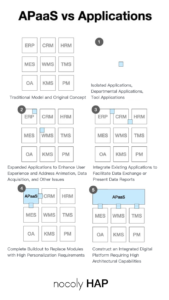
There’s no one-size-fits-all answer to whether Application Platform as a Service (APaaS) can replace conventional enterprise application suites. Just as some businesses prefer Traditional Enterprise Applications, others might opt for fully customized systems based on their specific IT capabilities and governance requirements.
As a relatively new category in enterprise software, APaaS is constantly evolving and improving. Its capability to replace standardized applications strengthens over time.
Initially, APaaS is particularly well-suited for creating standalone departmental applications. These applications, which address single problems without needing integration with other systems and are used by relatively small user groups, can be built quite conveniently using zero-code/low-code approaches. For instance, applications for equipment inspections in manufacturing, order summaries in a business department, or project management tailored to specific departmental needs are typical examples.
The next level involves extending existing systems. For instance, a manufacturing ERP might need to extend to work orders and waybills, or a CRM system might need to capture sales leads from marketing activities. Extending around a single application isn’t overly complex as long as data integration challenges are addressed. Even if data integration is difficult due to a lack of APIs in existing products, regular data imports and exports can often solve this issue. Our colleagues in the US, for example, often cite SAP Extensions as a prime use case.
At a deeper third level, integration becomes intensive, aiming to facilitate data flow between different systems. A business might have both a Marketing Automation System (MAS) and a Sales Force Automation (SFA) system that are disjointed. A fully capable APaaS can build data bridges between these systems and maintain data for cross-boundary business analytics.Reaching this level typically means that a business already has several established systems, and a complete overhaul isn’t practical. Therefore, alongside using APaaS, solving data integration issues is crucial. Solutions range from file exchange to more modern approaches like standardized RESTful APIs, which are common in most contemporary SaaS products.
At the fourth level, APaaS is used to custom-build complete applications that are central to a business’s core operations, such as CRM, ERP, or Project Management Systems (PMS). Which system is more central depends entirely on the industry and operational model of the business.
The highest level of APaaS utilization involves using its flexibility to build comprehensive digital systems encompassing marketing, sales, operations, service, and management accounting. If the implementer has a sound data model, constructing a comprehensive in-house solution with APaaS is within reach. The advantages include speed, cost-efficiency, and, importantly, the elimination of data silos often created by disparate applications. However, building a complex business-wide system is not trivial and requires substantial architectural expertise.
The diagram below outlines the relationship between application platforms and products, along with the five levels of application depth described above.

In conclusion, while APaaS has the potential to replace some application products, it’s neither capable nor necessary to replace all applications. This includes:
- Highly specialized systems that aren’t typical relational database applications, such as hotel PMS with complex dynamic pricing calculations or restaurant POS systems requiring refined hardware integration.
- Highly standardized applications for which the market already provides ample and adequate solutions. Sometimes, purchasing an application might even be less costly than building and maintaining one on APaaS.
- Advanced system-level application products that already offer high granularity customization capabilities, like Microsoft Dynamics, Odoo, Oracle APEX, or Salesforce Lightning. APaaS’s capabilities align with the customization features of these products, but application platforms take customization to the extreme.


